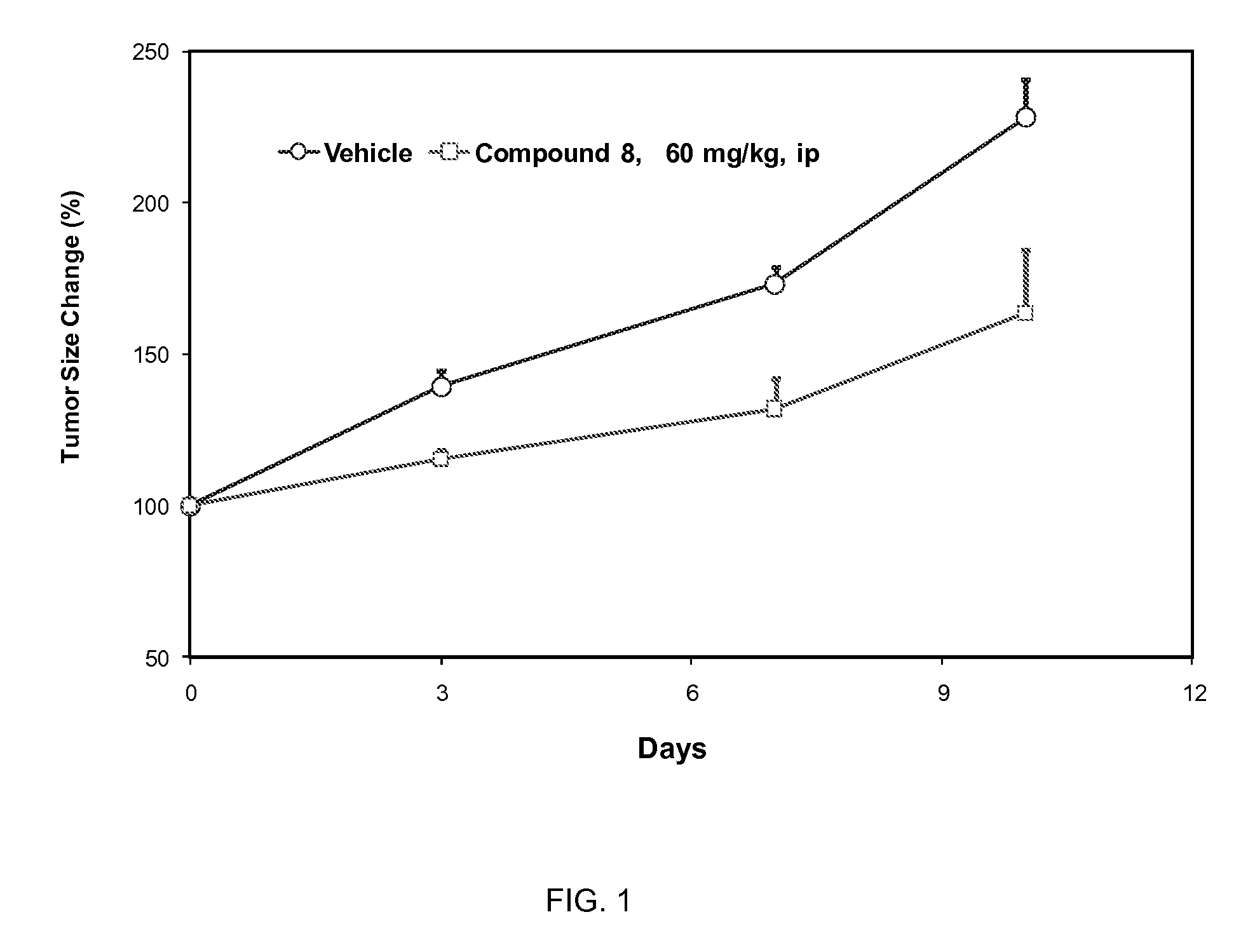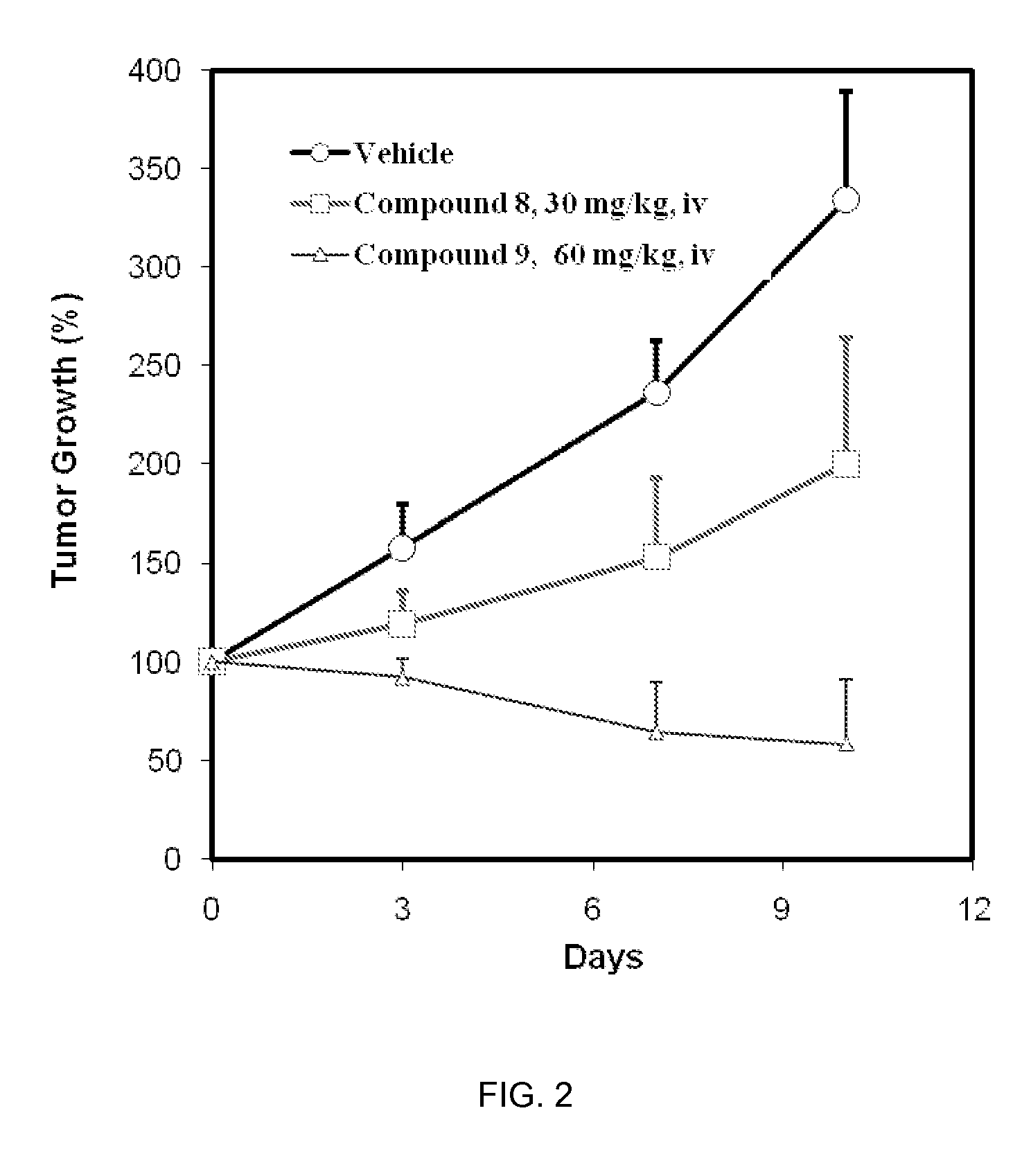CDK inhibitors containing a zinc binding moiety
a zinc binding and inhibitor technology, applied in the field of serine/threonine kinases, can solve the problems of limited ability to use such combinations, increased regulatory requirements for demonstrating safety and efficacy of combination therapies, and increased regulatory requirements for corresponding single agent trials, etc., to achieve enhanced and unexpected effects of inhibitors
- Summary
- Abstract
- Description
- Claims
- Application Information
AI Technical Summary
Benefits of technology
Problems solved by technology
Method used
Image
Examples
example 1
Preparation of N-(5-((5-tert-butyloxazol-2-yl)methylthio)thiazol-2-yl)-1-(4-(hydroxyamino)-4-oxobutyl)piperidine-4-carboxamide (Compound 1)
Step 1a: α-Azidopinacolone (Compound 0102)
[0168]To a 1 L round-bottom flask fitted with a magnetic stirrer was added α-chlorpinacolone 0101 (33.5 g, 0.25 mol), acetone (400 ml), and sodium azide (21.2 g, 0.325 mol). The reaction mixture was stirred at 25° C. overnight and then filtered, and the solids were washed with acetone. The filtrate was concentrated in vacuo to provide the title compound 0102 as an oil (34.3 g, 100%). The crude material was used in the next step directly without further purification. 1H NMR (CDCl3): δ1.17 (s, 9H), 4.07 (s, 2H).
Step 1b: α-Aminopinacolone hydrochloride (Compound 0103)
[0169]To a 2 L round-bottom flask fitted with a magnetic stirrer were added compound 0102 (34.3 g, 245 mmol), methanol (1100 ml), concentrated HCl (24 ml), and 10% Pd / C (4.2 g, wet, ˜40% water). The reaction mixture was stirred under hydrogen at...
example 2
Preparation of N-(5-((5-tert-butyloxazol-2-yl)methylthio)thiazol-2-yl)-1-(5-(hydroxyamino)-5-oxopentyl)piperidine-4-carboxamide (Compound 2)
Step 2a: Methyl 5-(4-(5-((5-tert-butyloxazol-2-yl)methylthio)thiazol-2-ylcarbamoyl)piperidin-1-yl)pentanoate (Compound 0111-2)
[0178]The title compound 0111-2 was prepared as a yellow solid (126 mg, 38.7%) from compound 0110 (250 mg, 0.658 mmol), methyl 5-bromopentanoate (128 mg, 0.658 mmol), K2CO3 (90.8 mg, 0.658 mmol), and DMF (5 ml) using a procedure similar to that described for compound 0111-1 (Example 1): LCMS: 495 [M+1]+.
Step 2b: N-(5-((5-tert-butyloxazol-2-yl)methylthio)thiazol-2-yl)-1-(5-(hydroxylamino)-5-oxopentyl)piperidine-4-carboxamide (compound 2)
[0179]The title compound 2 was prepared as a yellow solid (20 mg, 15.8%) from compound 0111-2 (126 mg, 0.255 mmol) and freshly prepared hydroxylamine solution (1.5 ml, 2.55 mmol) using a procedure similar to that described for compound 1 (Example 1): M.p.: 93-97° C.; LCMS: 496 [M+1]+. 1H NM...
example 3
Preparation of N-(5-((5-tert-butyloxazol-2-yl)methylthio)thiazol-2-yl)-1-(6-(hydroxyamino)-6-oxohexyl)piperidine-4-carboxamide (Compound 3)
Step 3a: Ethyl 6-(4-(5-((5-tert-butyloxazol-2-yl)methylthio)thiazol-2-yl-carbamoyl)piperidin-1-yl)hexanoate (Compound 0111-3)
[0180]The title compound 0111-3 was prepared as a yellow solid (210 mg, 51%) from compound 0110 (300 mg, 0.789 mmol), ethyl 6-bromohexanoate (176 mg, 0.789 mmol), K2CO3 (108 mg, 0.789 mmol) and DMF (5 ml) using a procedure similar to that described for compound 0111-1 (Example 1): LCMS: 523 [M+1]+.
Step 3b: N-(5-((5-Tert-butyloxazol-2-yl)methylthio)thiazol-2-yl)-1-(6-(hydroxyamino)-6-oxohexyl)piperidine-4-carboxamide (Compound 3)
[0181]The title compound 3 was prepared as a yellow solid (30 mg, 15.8%) from compound 0111-3 (210 mg, 0.40 mmol) and freshly prepared hydroxylamine solution (2.5 ml, 4.0 mmol) using a procedure similar to that described for compound 1 (Example 1): M.p.: 127-130° C.; LCMS: 510 [M+1]+. 1H NMR (DMSO-d6...
PUM
| Property | Measurement | Unit |
|---|---|---|
| body weight | aaaaa | aaaaa |
| body weight | aaaaa | aaaaa |
| temperature | aaaaa | aaaaa |
Abstract
Description
Claims
Application Information
 Login to View More
Login to View More - R&D
- Intellectual Property
- Life Sciences
- Materials
- Tech Scout
- Unparalleled Data Quality
- Higher Quality Content
- 60% Fewer Hallucinations
Browse by: Latest US Patents, China's latest patents, Technical Efficacy Thesaurus, Application Domain, Technology Topic, Popular Technical Reports.
© 2025 PatSnap. All rights reserved.Legal|Privacy policy|Modern Slavery Act Transparency Statement|Sitemap|About US| Contact US: help@patsnap.com



